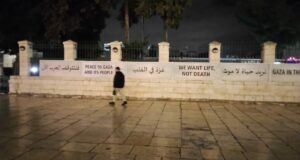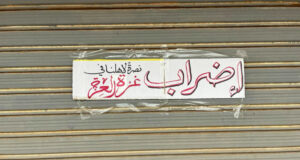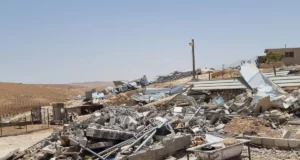by Ian
After a period of fine weather, the city now has Biblical floods and power cuts. It’s difficult to know what’s going on down the road, let alone in the UK. Still, droplets of news dribble in. Apparently campaigning for next year’s General Election is underway, and political debate is shifting to domestic issues. Law and order. Immigration. The National Health Service.
What a dream the NHS seems here. Despite the Labour Government’s fetish for privatisation, it’s still (so far) a free service for British citizens. Under pressure, like the rest of the welfare state, but it remains a cornerstone of our civilised society.
It has its critics. A running story in the national press for some time now has been the scandal of an NHS ‘postcode lottery’. Why should someone in Hampshire, say, have better services and shorter waiting lists than someone in Lancashire? Where you live shouldn’t affect your rights as a patient…
In post-Arafat Palestine too, an election looms, though the debate about domestic issues here now has a desperate urgency.
Law and order, for instance. The basic principle back home is to protect members of the public. What a miracle that would be for the Palestinian people, who have no say at all in how law and order is administered in the West Bank. The law is made in West Jerusalem and Tel Aviv, and enforced in Palestine by the occupying forces. On the ground, it is harsh, improvised and often lethal.
Unemployment? Someone told me the other day that unemployment in the militarised Hebron region is currently running at 78%. Impossibly high, but who knows? It’s impossible to verify. The economy here is as smashed as the infrastructure. Surrounded and controlled by a state raking in billions of dollars a year in foreign aid, Palestine’s poverty is in the third world league. Families scrape together whatever they can from any part-time, menial, temporary work they can get.
And immigration? This really is a mind-bender. There are plenty of people flooding into Palestine looking for a better life, but they’re not returning Palestinians. Nor are these new settlers asylum-seekers fleeing persecution, or migrants making a positive economic contribution in their host country. They are here for the subsidised housing in rapidly expanding settlements. They are here to steal farming land. Many of the latest wave of settlers in and around Hebron are from America, the richest country on earth, and they are here to rob the poor.
As for the state of the health service in Palestine, you need only visit the Mohammad Ali Hospital to see how the ‘postcode lottery’ operates in Hebron. The hospital is in H2, the eastern section of town that includes the Old City and inner suburbs. It is a military zone, and under an Israeli administration.
Before the second Intifada, the 280-bed hospital dealt with 80% of admissions in Hebron district. Now it deals with just 28%. Fear keeps people away. It’s not just the roadblocks patients must negotiate to get there, or the dangers of being detained by soldiers when you need urgent medical assistance. Simply being in an ambulance here is dangerous.
The Palestine Red Crescent Society isn’t ‘recognised’ by those who control H2. ‘Terrorists’ may be using ambulances, so emergency vehicles can find themselves the targets of gunfire. Snipers are everywhere. Tanks are stationed at high strategic points around the city. Six ambulances have been destroyed in the last three years.
‘You can be held up at a roadblock for two hours, even if you have called the DCO (the local Israeli administrative commander) to tell them you are sending an ambulance’ says senior consultant Firas Amro. ‘If it’s an emergency – someone with a serious myocardial infection – in half an hour he will be dead. A woman in labour – she can’t wait. We regularly have babies delivered at checkpoints.’
Getting patients to the hospital is difficult, but it’s just as difficult to attract money. There is no National Health Service here. Theoretically, treatment is paid for. Sometimes the Palestinian Authority will cover costs if a patient is sent down from Ramallah or Nablus. Sometimes patients will pay the full amount, sometimes half. Often they can afford to pay nothing.
Infant and paediatric services here are in crisis. Hebron’s population is over half a million. More than 50% are under 15 years old. Thirty new specialist paediatric spaces were created this year, bringing the district total to 100, provided by the PRCS and the district’s two government hospitals. A similar catchment area in Israel would have about 500.
Mohammad Ali Hospital is now the main centre for neonatal care in the southern West Bank. If premature babies survive the trip, they have a chance. And life in Hebron is very much a game of chance, the odds stacked according to your nationality.
The other day I saw three teenage settler girls strolling home along a Jewish-only road, barred to Palestinian traffic. They felt secure enough. They were being followed by an Israeli Defence Force jeep, meekly travelling at the pace they set. Now I am being told of a Palestinian boy, 17 years old, out with his friends when he was taken by Israeli soldiers. He was later admitted to hospital. Dead on arrival. He had been thrown from a moving jeep.
The death of a Palestinian may glimmer briefly in the day’s news. But beyond the grim, growing list of fatalities lies a vast number of less newsworthy victims – the maimed, the physically and mentally disabled.
This largely unseen problem, amplified to grotesque proportions by a brutal Occupation, is a huge project for the PRCS. Not only are they struggling to reach and deal with damaged children – particularly in rural areas – they are also battling traditional community attitudes to disability. Until recently physical handicap and mental illness meant shame for the family. The disabled were looked after by their nuclear family. And kept out of sight.
Now the PRCS is running social programs, bringing mobile care units to remote villages, offering respite care and rehabilitation services, raising awareness. A series of educational films on the causes of and treatment for disability (i.e a biological explanation rather than the infuriating default one of Fate, or God’s Bloody Will) is now airing on local TV stations. Almost anywhere else in the world, this public service would be paid for by the government in charge. The TV audience isn’t Israeli, though, so an international charity is funding the campaign.
Al-Raja Centre, just outside Hebron City, is a PRCS day care unit for 80 children, aged 6 upwards. There’s a range of activities – physical and psychological therapy, special needs teaching, even greenhouses and a chicken farm. Farming teaches, but it also feeds. And, importantly, produce earns money for the centre.
There’s some wonderful, progressive work going on here. As part of its awareness campaign, the PRCS has recently called for 5% of employees to be disabled, a target it already exceeds at Al-Raja. The ethos is integration – a regular kindergarten brings day care kids and local children together, and craft workshops teach embroidery and bamboo furniture-making.
This isn’t just occupational therapy. Older teenagers can move from Al-Raja into Hebron’s local craft industries. It is, staff say, one of the most satisfying outcomes of their work. Rebuilding bodies and minds – whether damaged at birth or splintered by the random violence of the Occupation – is a slow process. To see hope and self-esteem inch back over the years is gratifying. But to watch kids move from shameful sequestration at home to enlightened day care to a proper job is cause for jubilation.
The centre building is spartan. Built in 1981, it feels like a cheap 1960s comprehensive school. The rusting hulk of a clapped-out Red Crescent ambulance has been hoisted onto a roof as an improvised logo. For director Tayzir Maraqa, as with every senior health official, the job seems to be half admin, half fundraising. The centre plans to build another storey soon, increasing capacity to 140 (thanks, Spain) and at least the stone classroom floors are a bit warmer now – another overseas donor has provided carpets.
A long-term plan is to establish a bottle-making factory – Hebron glass is celebrated throughout the West Bank, even grudgingly in Israel – to generate more income and provide more jobs for Al-Raja children. But first they must find a donor. And then get the money. And then face another hurdle. ‘The problem is transferring the money’ says Maraqa. ‘The UN, whoever…you’re promised the money, they they (the Israelis) say this money is not to aid development, it is to build a bomb…’
PRCS staff are loyal, and patient. According to Firas Amro, ‘you maybe get a salary cheque every two or three months…’ Medicines and equipment are much harder to get since 9/11. ‘We used to receive funding from the UAE, Saudi Arabia. Now Bush says no money can be transferred, we are financially threatened. It is very hard.’
He too spends a lot of his time writing letters and emails to charities asking for help – ‘begging for aspirin, even. Much of the stuff we get from overseas is past its expiry date or surplus to requirements. I just wish most of the people I write to would even respond. Usually, there is no reply.’
When medicines do arrive, they can be held up for weeks at the airport, for security reasons or just out of bureaucratic spite, so that by the time they get to the hospital they are useless. Sometimes soldiers interfere: ‘We had a vaccination programme for 2-5 year olds recently. Soldiers stopped the ambulance trransporting the vaccine, which cannot be exposed to light, insisted we unload all the boxes and then opened them. They wouldn’t listen. The vaccine was ruined.’
At the PRCS ambulance and emergency unit in Hebron, there are two buildings. One is a low, beaten-up old block at the end of an unmade, potholed road. It functions both as a general treatment and dispensing centre and as the area’s main ambulance despatch station.
The other is an unfinished 7-storey building, Hebron’s new A&E hospital. The shell has been constructed ‘by the will of Allah and the help of some local and international NGOs…’ Like almost every other building in Hebron, it sprouts metal rods from the top. There’s no cladding, no glazing. They’ll have to find the money to complete it, then find the money to fit it out, then find the money for equipment…
For now, the nerve centre for Hebron’s emergency services is a cramped control room with what would be, at home, a sylishly retro swichboard with proper old-school telephone handsets. On the admissions sheet there’s a log entry for the 19 year-old admitted yesterday with serious wounds. He’d been demonstrating against the Apartheid Wall at Beit Ula and caught live fire. In through his shoulder, out through his back, taking his spleen and a kidney on the way. When we visited the site of the demo – a beautiful mountain valley dotted with ancient Canaanite caves and Roman ruins, just about the worst place in the world to erect a giant concrete barrier – people there were convinced an explosive bullet had been used, illegal under international law. Like almost everything else that happens to Palestinians. The young man will live but he’ll be permanently disabled.
Perhaps he’ll need a wheelchair. Today, the PRCS are celebrating the news that 100 chairs (another gift from far beyond the borders of the ‘only democracy in the Middle East’) are to be delivered this week. I hope they’re in better shape than the one I saw being unloaded from a PRCS ambulance amid the rubble of a devastated street.
An elderly woman was being decanted. It was the closest the paramedics could get to her home, wherever that is, as the road had been blocked by several lumps of concete, each a cubic meter. They create a ‘no go’ zone around Worshippers’ Way, a settler road.
This is how you end your days in Hebron, assuming you die of natural causes. Bumping through rubble onto a steep hill where your ambulance isn’t allowed. The PRCS has some burly volunteers for this. Many of Hebron’s roads are surreally steep. Some feel like they’re only a couple of degrees from being walls. There she was, the old lady, being trundled home along the same road where occupying forces escort their teenage children with jeeps following behind at walking pace.
And this is how you start your days in Hebron if you’ve arrived too early – at the Mohammad Ali Hospital, in the heart of H2. Your ticket in the postcode lottery. Born into a society abandoned by the world to the arbitrary will of an oppressive military power.
This is a place brutalised, traumatised by violence and death, where divorce rates are soaring, where job prospects are close to zero, where children play war games. Where, in postcode H1 outside the military zone, hospital doctors arive at work to find 250 patients waiting. Some have queued since 4a.m.
If the Occupation ended now, it would take years, generations, for the wounds to heal. ‘Our children face extreme violence every day’ says Firas Amro. ‘The psychological effect of this is unimaginable. You can cry, and you can stop crying. Something happens to people when they become used to families falling apart, when they can no longer depend on shelter, food, water, their brothers and sisters, when they know hate, when they believe they are going to die. Death has many faces here. One of them is Israeli.’
What could possibly upset a doctor on the Hebron front line, when this shit is going on round the clock, week after week, year after year? The medical director of Mohammad Ali, Said Natsheh, has seen more misery than most. Yet the incident he recalls now with a distracted look happened a decade ago. 1994, the year of the Oslo Agreement, was also the year of the Goldstein Massacre in Hebron. A Jewish settler (from what the AA guide Explorer Israel calls the ‘tough-minded’ settlement of Kiryat Aba) entered the Ibrahimi Mosque and opened fire on worshippers, killing 29 and wounding many more.
Ensuing violence in the town saw Mohammad Ali hHospital occupied continuously for three days by heavily-armed troops. And from his overflowing memory of the suffering this caused to patients and staff, and from all the death and pain he has witnessed since, this doctor is momentarly baffled and disturbed by one small memory.
A little girl, four or five years old with meningitis, siting in a chair. He remembers the soldier, searching for something to stand on to get a better view from a high window. He just grabbed the chair, spilling the child to the floor. As though she didn’t exist. Rage at this split second of callousness has burned inside him for 10 years.
And then we go upstairs to the premature baby unit. It’s difficult to write this. Not because I see anything horrible. Here, afer all, is hope. The babies here made it. Many don’t. There are four babies in incubators, born in Hebron and born too early – between 28 and 30 weeks.
Of these four, one has permanent brain damage (oxygen starvation) but will live. Another has meningitis and severe heart and lung problems and will die. The chances are good for the other two, and I’m looking at one of them now. He’s as big as a skinned rabbit, tubed up and wired in. The monitor is calm and steady. He has a lung infection but he will survive – another miracle.
He should be dead. His mother went into early, sudden labour. There were complications. This little boy without a first name on his medical sheet was born in a village house an hour away from the hospital. The family is poor – it can’t afford to pay for medical treatment, can’t afford transport.
A twist of fate – a nurse from Muhammad Ali is a neighbour. She brought the child in and has agreed to pay at least something towards his care in the premature unit.
And I am thinking about the 10 minutes or so before the nurse arrived to take control. This child had been abandoned at birth. Not dumped somewhere, or murdered, but born, loved and watched in despair. What must it do to your mind, to look at your newborn child and know that you are powerless, that you can only lie there with him while he dies?
I can’t get it out of my mind. I have seen both my children born, watched them grow and thrive. And I am standing here, trying not to fucking cry, trying to think myself into the head of a parent looking at this tiny thing and feeling only anguish. I may cry later, but for now I am burning with rage.
 International Solidarity Movement Nonviolence. Justice. Freedom.
International Solidarity Movement Nonviolence. Justice. Freedom.


